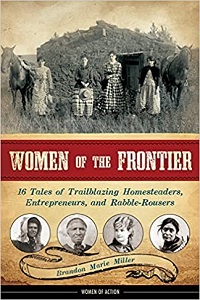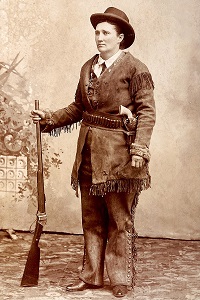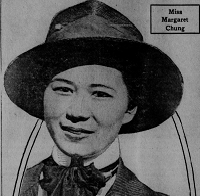How will these resources help you?
The main focus of many resources about the American West of the 1800s detail the impact male pioneers and white settlers had on its development. These resources are intended to develop teaching about the significant and varied roles women played as pioneers and settlers, while looking at the hardships they faced. The resources can be used to emphasise the social and cultural diversity of the American West, highlighting the vital yet often under-represented impact women had upon their communities and on wider society.
Influential women pioneers

Women of the Frontier: 16 Tales of Trailblazing Homesteaders, Entrepreneurs, and Rabble-Rousers
by Brandon Marie Miller, published by Chicago Review Press, (2013), 9781883052973
This accessible collection of illustrated short accounts of women and their roles in the settlement of the American West is a great starting point, supporting teaching and further research. Each chapter starts with a useful summary about the roles of women on the journey west: as homesteaders, during the gold rush and also during times of conflict. You could use the account of the experiences of Margaret Reed and Amelia Stewart Knight to highlight the terrible hardships and courage of women on the difficult journey west. The story of Clara Brown can be used to look at the contribution African American women made to the Gold Rush of 1859.The story of Narcissa Whitman gives an interesting insight into the prejudices held by white settlers when they encountered indigenous peoples of North America. The book includes the story of Thocmetony, later known as Sarah Winnemucca, who worked tirelessly as an activist and an interpreter campaigning for the rights of the Paiute people in the face of government oppression and mistreatment. You could use the material to open up debate about the power of and use of historical terms, with ‘Native American’, ’American Indian’ and ’Indian’ all referenced within this book. The final two stories can be used as an interesting comparison of women who were captured by the Comanche, Rachel Palmer Plummer who suffered as a ‘slave’ and Cynthia Ann Parker who married a chief and refused to return to white society.
Changing roles in society

Not Just a Housewife: The Changing Roles of Women in the West
by National Cowboy & Western Heritage Museum
This article summarises an exhibition that explores the role of women as artists, gamblers, prospectors, rodeo personalities, musicians, actresses and prostitutes. The resource can be used to include more detail about the varied societal roles of women who are often under-represented in traditional accounts. Often, the focus is on the role of women as ‘homemakers’ or ‘settlers’: these stories from 13 different women can be used to challenge that idea. The stories of Martha Jane Cannary, Ellen Elliot Jack and Alice Ivers can all be used to counter the idea that women were simply there to look after their husbands and raise children.
Greater opportunities?

Women and the Myth of the American West
by Zócalo Public Square, published by Time Magazine, (2015)
This resource is a very useful collection of six wide-ranging short articles by female historians in response to the question 'What opportunities did the American West offer women that they may not have had back East?'.
Further materials
Letitia Carson (ca. 1814–1888) by Bob Zybach, published by BlackPast, (2015)
Read this article
Seven Journeys in the American West (video clips from the series) by BBC Two, (2023)
Watch this video
Bethenia Owens-Adair (1840–1926), published by Oregon Historical Society, (2002)
Read this article
Rebecca Jarvis is an experienced secondary school history teacher who has taught in her current school for 16 years. She is also a GCSE senior examiner.
Text © Rebecca Jarvis, 2021-2023.
Text © Rebecca Jarvis, 2021-2023.



